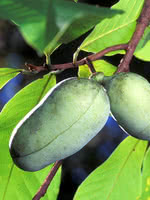Mon-Fri 9am - 5pm Mountain time
Patterson Pride Plum vs Pawpaw
Asimina triloba
Prunus nigra x salicina Patterson Pride
The Pawpaw tree produces delicious, sweet fruit with a unique banana-mango flavor. These oblong fruits start yellowish-green and mature to a dark brown in the fall. It is best to leave them on the tree until ripe, as they do not ripen well once picked. Pawpaws can be enjoyed fresh, in baking, or in ice cream.
Pawpaws produce the largest native fruit in North America. They typically grow as a small understory tree or large shrub on wooded slopes, in ravines, and along stream banks. They often spread through root suckers, forming dense thickets over time.
For fruit production to occur more than one genetically different Pawpaw tree is required. Our Pawpaw seedlings are grown from seed so they are all genetically different.
Note: Avoid eating the seeds and skin of the Pawpaw fruit as they can cause stomach pain for some individuals. Contact with the skin of the fruit can also result in skin irritation, so it is recommended to wear gloves during harvest. Plant this tree once. Due to its large tap root transplanting is not recommended.
The Patterson Pride Plum is known for its delicious flavor, with firm, sweet golden flesh and dark red skin that isn’t sour. The freestone plums can grow 4-5 cm in diameter and are well-suited for fresh eating, baking, and preserves. It can produce heavy yields that ripen in mid-September which is later than other plums.
C.F. Patterson developed the Patterson Pride Plum at the University of Saskatchewan. It is known for its semi-dwarf, weeping growth habit
Patterson Pride Plum is a hybrid between Canada Plum and Japanese Plum. For fruit production, it needs to be planted with another variety for cross-pollination. Canada Plum and American Plum are considered universal pollinizers.

